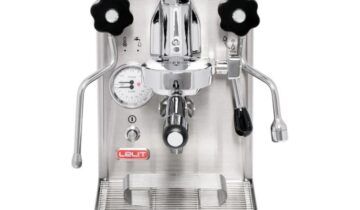Techniques and Recipes for Exceptional Espresso
The world of home espresso has transformed dramatically in recent years. With innovations like the Cafelat Robot, once-exclusive espresso-making techniques are now accessible to coffee enthusiasts without the need for expensive, bulky machines. The Cafelat Robot, with its minimalist design and manual lever system, has become a favorite among coffee lovers for its ability to produce high-quality espresso without a pump, all while taking up minimal counter space.
Why Choose the Cafelat Robot?
The Cafelat Robot stands out for its robust craftsmanship, ease of use, and charming design. But don’t be fooled by its toy-like appearance—this machine is serious about espresso. By manually controlling the lever arms, you generate the necessary pressure to extract a rich, syrupy espresso shot. Unlike traditional espresso machines that are fixed at 9 bars, the Robot allows you to adjust the pressure throughout the extraction process, offering a level of control typically found only in much more expensive equipment.
Brewing with the Cafelat Robot: A Step-by-Step Guide
The Basics
The oversized filter basket of the Robot doubles as a brewing chamber. Since the machine doesn’t have a built-in heating element, you’ll need to fill the basket with hot water from a kettle. Once you pour water just off the boil into the basket, it naturally cools to around 95°C—ideal for brewing a perfect espresso shot.
To brew with the Cafelat Robot, follow these essential tips:
- Use Freshly Ground Coffee: Grind your beans just before brewing to capture the freshest flavors.
- Proper Water Filling: Fill the basket with hot water up to 5-8mm below the rim. Avoid weighing the water into the basket to ensure it’s adequately filled.
- Pre-Heating: For lighter roasts, pre-heat the portafilter and basket to enhance extraction.
- Consistent Tamping: Apply even pressure when tamping, but don’t overdo it.
- Effective Pre-Infusion: Let the water soak into the coffee at low pressure before the main extraction to ensure even saturation.
- Lever Control: Avoid pumping the lever arms up and down, as this can disturb the coffee puck and compromise your shot.
- Start with a 16g Dose: Aim for a 1:2 ratio (16g coffee to 32g espresso) and adjust to taste.
To explore our range of high-quality Cafelat espresso equipment, including the WDT tool for Cafelat Robot and other premium accessories, visit our Cafelat Robot shop. We offer a variety of products designed to enhance your espresso-making experience and deliver exceptional results. Whether you’re a seasoned barista or a coffee enthusiast, you’ll find the tools you need to craft perfect espresso every time.
The Declining Pressure Espresso Recipe: Unlocking New Flavors
One of the most exciting features of the Cafelat Robot is its ability to manipulate pressure throughout the extraction process. This recipe takes full advantage of that capability, offering a shot with enhanced clarity and acidity—a different experience from the traditional 9-bar espresso.
The Declining Pressure Espresso Shot Recipe
This recipe is divided into four key stages:
- 2-Bar Pre-Infusion: Begin by applying about 2 bars of pressure to the espresso puck. This low-pressure pre-infusion allows the coffee to soak evenly, ensuring consistent extraction.
- Ramp Up to 9 Bars: Gradually increase the pressure to 9 bars for the first half of the extraction, approximately 20 mL. This stage extracts the bulk of the espresso’s rich flavors.
- Ramp Down to 6 Bars: Reduce the pressure to around 6 bars for the next 10 mL, focusing on extracting more nuanced flavors.
- Final Ramp Down to 3 Bars: Finish the shot by lowering the pressure to about 3 bars for the last 10 mL, bringing out a lighter body and more perceived acidity.
We highly recommend checking out the Cafelat Robot WDT Tool and Tamping Stand, produced by Papel Espresso, for optimal espresso brewing. These tools are designed to enhance your coffee preparation process, ensuring precise and consistent results every time. Explore how they can elevate your espresso experience at Papel Cafelat WDT.
A pressure gauge, if available, is incredibly helpful in executing this recipe accurately. If your Robot doesn’t have a pressure gauge, you can still achieve similar results by simply reducing the pressure you apply as the extraction progresses.
Why Declining Pressure?
Espresso is a complex beverage, and the pressure applied during extraction plays a significant role in the final flavor. While the Specialty Coffee Association (SCA) defines traditional espresso as being brewed at 9 bars, adjusting the pressure can highlight different aspects of your coffee. By using declining pressure, you can create a shot with a lighter body and more pronounced acidity, offering a refreshing contrast to the usual dense and rich espresso.
The Importance of the Right Scale
One challenge with the Cafelat Robot is finding a scale that fits between its bars. A scale with a built-in timer and quick response time is essential for precise measurements, ensuring consistency in your espresso shots. Fortunately, there are affordable options available that fit perfectly with the Robot.
Fine-Tuning Your Espresso
- Trust Your Taste: Your taste buds are the ultimate guide. If your espresso tastes good, you’re on the right track.
- Focus on Grind Adjustment: Start by adjusting only the grind setting while keeping the dose and ratio consistent. Once you’ve mastered this, you can experiment with tweaking other variables.
- Practice Pre-Infusion: The manual lever on the Robot gives you full control over the pre-infusion and extraction process. Use this to your advantage to create shots that suit your personal taste.
By combining these techniques and recipes, you can unlock the full potential of the Cafelat Robot, producing espresso that rivals professional machines and tailoring each shot to your personal preferences. Happy brewing!



 No products in the cart.
No products in the cart.